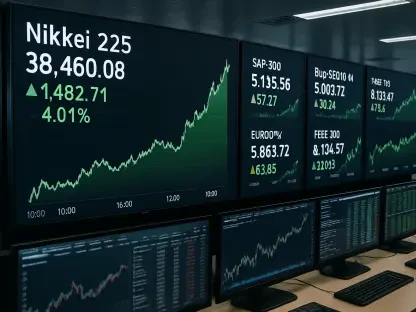As the financial world intensifies its focus on forthcoming economic data, investors remain cautiously optimistic about the implications of inflation statistics and the earnings of major banks. The stakes are raised as these indicators hold the potential to substantiate or challenge current market trajectories amid a backdrop of geopolitical tensions and economic policies. This analysis explores the nexus of inflation expectations, interest rate strategies, and the influence of corporate earnings, framing a comprehensive narrative of the current economic climate.
Monitoring Inflation and Bank Earnings
Importance of Consumer Price Index
US stock futures recently showed signs of measured optimism, which can largely be attributed to impending economic data, particularly the Consumer Price Index (CPI). The CPI serves as a barometer for inflation, tracking changes in the pricing of goods and services by households. Investors regard the CPI data as paramount, especially in light of recent tariffs that threaten to increase prices across various sectors. This report is anticipated to reveal a monthly increase of 0.3%, with a yearly rise of 2.4%, marking the potential onset of price escalations triggered by recent trade policies. This inflation data will play a critical role in shaping expectations and influencing the investment landscape.
Major banks are also front and center as they begin to report earnings, with institutions such as JPMorgan, Citi, and Wells Fargo set to reveal their financial performances. These earnings reports are crucial in reassuring investors that the effects of tariff disputes have been contained for now, with the potential for recovery in the latter half of the year. How these banks perform not only against their own benchmarks but also in the context of broader economic narratives, is being closely scrutinized. Especially significant are their perspectives on how tariffs have influenced their operations and what assurances they can provide moving forward.
Inflation, Tariffs, and Economic Strategies
The ongoing geopolitical dynamics, primarily driven by the U.S. administration’s tariff policies, add another layer to the complex picture of inflation and banking performance. Recent rhetoric from the Trump administration, emphasizing the importance of high tariffs on strategic trade partners, compounds uncertainty. These policies are seen by many as both an opportunity and a risk, conveying potential disruptions to global trade. President Trump’s communications underscore his philosophy of viewing negotiations as dynamic, ongoing dialogues rather than fixed agreements, impacting international economic relations significantly.
In response to these developments, the Federal Reserve faces considerable pressure to adapt its interest rate strategies. Although many analysts predict that the Federal Reserve will maintain its current rate levels for now, discussions around the possibility of reductions are ongoing, with potential adjustments scheduled for later in the year. President Trump has been vocal in advocating for deeper interest cuts, bringing fiscal policy into sharp focus. His critiques of Federal Reserve Chair Jerome Powell, particularly highlighting aspects such as monetary policy execution and infrastructure decisions, like the Fed’s HQ renovation, underscore the tensions between economic stewardship and political agendas.
The Intersection of Technology and Trade
Commodity Markets and Technological Initiatives
While tariffs and inflation dominate much of the economic discourse, commodity markets offer a unique perspective. Gold, often perceived as a safe haven during turbulent times, has experienced price fluctuations that mirror investor sentiment. Despite a strong performance earlier in the year, recent challenges related to global trade discussions have led to some volatility. Analysts emphasize that the outcome of ongoing trade negotiations will heavily influence the commodity market’s near-term performance. These dynamics echo greater uncertainties within investment landscapes, where risk aversion continues to play a pivotal role.
Technology markets are not immune to these trends, with companies like Nvidia providing clear examples of adaptive strategies. Nvidia’s recent efforts highlight the intersection of technological advancements and geopolitical considerations as it endeavors to navigate the complexities of international trade. The company has taken strategic steps to re-enter the Chinese market with its ##0 AI chip, pending approval from U.S. regulatory bodies. This move illustrates how firms are aligning their technology development and trade strategies to comply with both domestic regulations and international market opportunities.
Strategic Responses to Trade and Regulation
Nvidia’s ongoing adjustments reflect a broader corporate agenda that harmonizes technological innovation with regulatory compliance. By launching a new GPU model that adheres to U.S. export regulations, Nvidia aims to reinforce its position as a leader in artificial intelligence development while mitigating geopolitical risks. This cautious yet strategic approach underscores the broader narrative of how companies are maneuvering within complex international environments to maintain and strengthen their market presence. Collaborating with multiple stakeholders, Nvidia’s initiative captures the essence of a modern corporate strategy that responds adeptly to multifaceted geopolitical pressures.
Such technological strategies align with a renewed focus on corporate responsibility and adaptability within the shifting sands of international trade policies. As companies navigate regulatory landscapes and market demands, their strategic endeavors offer valuable insights into the broader economic narrative. These developments serve as a testament to the resilience and agility required in today’s global economic framework.
Conclusion – Navigating Uncertainties and Opportunities
As investors closely watch forthcoming economic data, they’re cautiously optimistic about the effects of inflation figures and leading banks’ earnings on the market. These indicators are crucial, as they might support or counter current market trends in a climate marked by geopolitical tensions and evolving economic policies. This analysis delves into the interplay between inflation expectations and interest rate strategies, examining how corporate earnings also play a role in shaping the prevailing economic landscape. With the market’s direction hanging in the balance, understanding these elements becomes essential for investors seeking to navigate through uncertainty. While inflation stats provide insights into potential cost fluctuations, bank earnings reveal the financial sector’s stability and health. Together, these aspects influence the broader narrative of today’s economic setting, shedding light on potential future developments and strategies that investors must consider while adapting to the dynamic environment.









